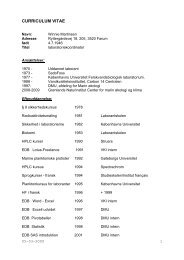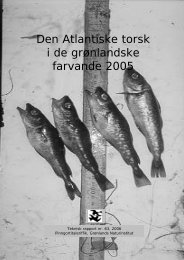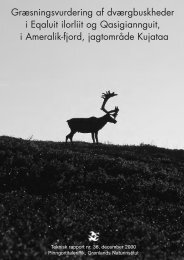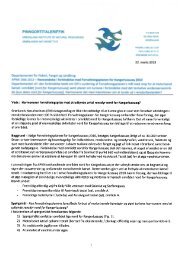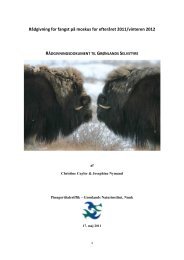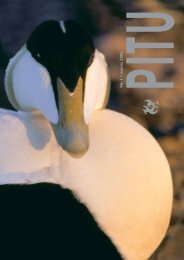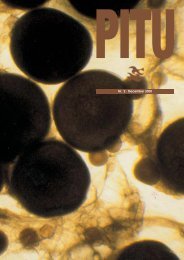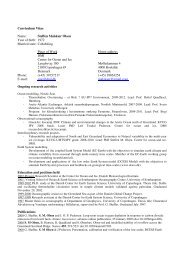Migration and breeding biology of Arctic terns in Greenland
Migration and breeding biology of Arctic terns in Greenland
Migration and breeding biology of Arctic terns in Greenland
Create successful ePaper yourself
Turn your PDF publications into a flip-book with our unique Google optimized e-Paper software.
46<br />
the number <strong>of</strong> <strong>in</strong>viable eggs <strong>in</strong> the clutch <strong>and</strong> the b<strong>in</strong>omial denom<strong>in</strong>ator<br />
was the total clutch size. Covariates fi tted to the model were calendar date<br />
<strong>and</strong> whether the eggs were <strong>in</strong> a fi rst or relay clutch. Model selection <strong>in</strong><br />
both cases was conducted us<strong>in</strong>g likelihood ratio tests. Both these models<br />
were implemented <strong>in</strong> SAS.<br />
Incubation <strong>and</strong> fl edg<strong>in</strong>g periods <strong>and</strong> their ranges were taken from the literature<br />
(Cramp 1985). SDs were estimated by generat<strong>in</strong>g r<strong>and</strong>om normal<br />
distributions from the published mean <strong>and</strong> iteratively varied SD values until<br />
the maximum <strong>and</strong> m<strong>in</strong>imum values matched the published range <strong>in</strong> values.<br />
The mean replacement period <strong>and</strong> its SD were estimated from the <strong>in</strong>tervals<br />
between clutch removal <strong>and</strong> relay<strong>in</strong>g <strong>in</strong> the experimental study plot.<br />
The start date (average date upon which <strong>in</strong>dividuals laid their fi rst clutch)<br />
<strong>and</strong> the stop date (the average date after which <strong>in</strong>dividuals would not<br />
<strong>in</strong>itiate further relay clutches) <strong>and</strong> their SD were estimated by iteratively<br />
vary<strong>in</strong>g these values <strong>in</strong> a simulation model <strong>of</strong> the lay<strong>in</strong>g season (see below<br />
for details). The result<strong>in</strong>g estimated frequency distribution <strong>of</strong> nest<br />
<strong>in</strong>itiation dates were compared with those observed <strong>in</strong> the experimental<br />
study plot. The values that m<strong>in</strong>imised the sum <strong>of</strong> the squared deviations<br />
between observed <strong>and</strong> expected values were those used <strong>in</strong> further simulation<br />
models (Green 1988, Ratcliffe et al. 2005).<br />
Simulation model<br />
A simulation models that allowed for re-nest<strong>in</strong>g (Be<strong>in</strong>tema <strong>and</strong> Müskens<br />
1987; Green 1988; Green et al. 1997; Ratcliffe et al. 2005) was used to estimate<br />
productivity <strong>and</strong> number <strong>of</strong> nest<strong>in</strong>g attempts made by <strong>Arctic</strong> <strong>terns</strong>,<br />
<strong>and</strong> the numbers <strong>of</strong> eggs that were harvested by humans, under a range<br />
<strong>of</strong> harvest management options. Options <strong>in</strong>volved variations <strong>in</strong> the date<br />
harvest<strong>in</strong>g started, the number <strong>of</strong> days the harvest rema<strong>in</strong>ed open <strong>and</strong><br />
the amount <strong>of</strong> harvest<strong>in</strong>g effort (spread equally over the open period) <strong>in</strong><br />
terms <strong>of</strong> man hours. We also only allowed one <strong>of</strong> the isl<strong>and</strong>s <strong>in</strong> the archipelago,<br />
Basisø, to be open to harvest<strong>in</strong>g, although the model has the fl exibility<br />
to <strong>in</strong>clude variation <strong>in</strong> the area open for harvest.<br />
Breed<strong>in</strong>g pairs were r<strong>and</strong>omly allocated to a management zone by generat<strong>in</strong>g<br />
a r<strong>and</strong>om probability: if this was less than the proportion <strong>of</strong> pairs occupy<strong>in</strong>g<br />
Basisø then the pair was at risk <strong>of</strong> harvest<strong>in</strong>g, otherwise they bred<br />
on another isl<strong>and</strong> where only natural mortality occurred. Breed<strong>in</strong>g pairs<br />
were also r<strong>and</strong>omly allocated <strong>in</strong>cubation, fl edg<strong>in</strong>g <strong>and</strong> replacement periods<br />
<strong>and</strong> a start <strong>and</strong> stop date, all <strong>of</strong> which were drawn r<strong>and</strong>omly from a<br />
normal distribution with the mean <strong>and</strong> st<strong>and</strong>ard deviation appropriate to<br />
each parameter. Clutch size was two unless a r<strong>and</strong>omly generated probability<br />
exceeded the estimated proportion <strong>of</strong> two egg clutches, <strong>in</strong> which<br />
case it was one. The lay<strong>in</strong>g period was calculated as the clutch size m<strong>in</strong>us<br />
1 day, on the basis <strong>of</strong> one egg be<strong>in</strong>g laid per day <strong>and</strong> <strong>in</strong>cubation started the<br />
day the last egg was laid.<br />
Dur<strong>in</strong>g each day <strong>of</strong> the lay<strong>in</strong>g <strong>and</strong> <strong>in</strong>cubation periods, the clutch was<br />
subjected to a likelihood <strong>of</strong> natural failure by test<strong>in</strong>g whether a r<strong>and</strong>om<br />
probability exceeded the date-specifi c daily nest survival rate until the <strong>in</strong>cubation<br />
period elapsed or the nest failed. On those days when harvest<strong>in</strong>g<br />
occurred, nests on Basisø were further subjected to a likelihood <strong>of</strong> be<strong>in</strong>g<br />
harvested <strong>in</strong> the same way. The daily likelihood <strong>of</strong> harvest-<strong>in</strong>duced failure<br />
was calculated by multiply<strong>in</strong>g the effort on that day by the probability <strong>of</strong>





